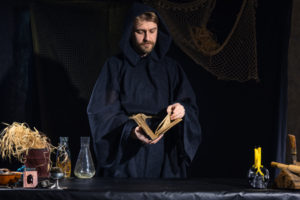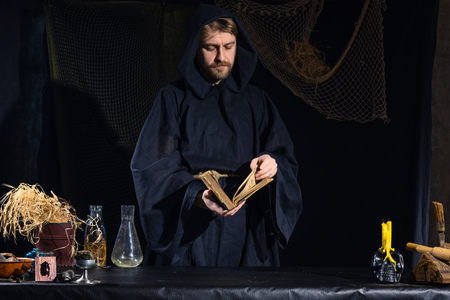
Carl Sagan and others described the Middle Ages as a time when scientific progress was thwarted by religion, specifically Christianity. In his book Cosmos, Sagan has a timeline of science and technology with a gap from around 500 AD to 1500 AD. At the bottom of the timeline he commented: “The millennium gap in the middle of the diagram represents a poignant lost opportunity for the human species.” But this portrayal of the Middle Ages is as false as saying Columbus discovered American and proved the earth wasn’t flat.
In a BioLogos article, “Carl Sagan and the Myth of the Medieval Gap,” Stephen Snobelen said it was axiomatic for those who perceive a conflict between religion and science to hold to this belief. Namely, that while “science” existed in ancient Greece, during medieval times it faded away until Christianity’s influence started to subside. Snobelen said only with some significant qualifications can we say: “science existed in Ancient Greece.” And this Greek period of “science” was already in decline before Christianity came to power.
“It is true that the first half of the Middle Ages did not enjoy the intellectual vibrancy of the second half.” But this can be explained by historical contingencies such as “the impact of Barbarian invasions and political dislocations.” By the end of the medieval period, “science and technology had reached a state of sophistication and refinement that far surpassed that of the Greeks.” And yet, the term “medieval” has become a sneering way of referring to something that someone thinks is backward.
Among the technological advances of the Middle Ages are the horse collar, the rudder, eye glasses, buttons, the fork, trousers, windmills, the mechanical escapement clock, and the printing press. The invention of the Cyrillic script, which is the basis of several alphabets, also occurred during the Middle Ages. The myth also ignores the innovations to the practice and theory of science that occurred during that time. Roger Bacon (1220-1292), a Franciscan, is known as the first modern scientist. William of Ockham (1285-1347) conceived of the parsimony principle—Ockham’s Razor.
But, if we play the correlation-equals-causation game (which is a fallacy to begin with), then this argument proves more than advocates of the Medieval Gap want. For instance, there is a common assumption that Europe in the Middle Ages and the Early Modern Period was a cultural monolith dominated by the Church. This can hardly be said of the first half of the Middle Ages. Yet, it was only when the Catholic Church had consolidated its power in the second half of the period that there was a relative flourishing of science and technology. More spectacularly, it was precisely the period when Europe was at its most Christian—the sixteenth and seventeenth centuries—that science as we now know it emerged. (I am not saying that Christianity was in any simple way responsible for the emergence of modern science, only that the correlation argument can come back to bite its proponents)
In his essay on the myth “That the Medieval Christian Church Suppressed the Growth of Science,” in Galileo Goes to Jail, Michael Shank said the idea that the Middle Ages was a “millennium of stagnation” brought on by Christianity has largely disappeared among Medieval scholars. “But it remains vigorous among popularizers of the history of science” who uncritically repeat these false assertions made of those who went before them. For example, John William Draper, asserted in 1874 (History of the Conflict Between Religion and Science) that the Church of the Middle Ages “became a stumbling block in the intellectual advancement of Europe for more than a thousand years.” Carl Sagan, in his 1980 book Cosmos said: “For a long time the human instinct to understand was thwarted by facile religious explanations.”
Another factor in the growth of science during the Middle Ages was the spontaneous development of universities around famous teachers in towns like Paris, Oxford, and Bologna. “By 1500, about sixty universities were scattered throughout Europe.” About 30 percent of their curriculum covered subjects and texts about the natural world. Hundreds of thousands of students were exposed to science “in the Greco-Arabic tradition.”
If the medieval church had intended to discourage or suppress science, it certainly made a colossal mistake in tolerating—to say nothing of supporting—the university. . . . Dozens of universities introduced large numbers of students to Euclidean geometry, optics, the problems of generation and reproduction, the rudiments of astronomy, and arguments for the sphericity of the earth. Even students who did not complete their degrees gained an elementary familiarity with natural philosophy and the mathematical sciences and imbibed the naturalism of these disciplines.
The majority of students at these universities did not study theology. Most were not priests or monks. “They remained in the faculties of arts, where they studied only nonreligious subjects, including logic, natural philosophy, and the mathematical sciences.” The most popular advanced study was law, which promised lucrative careers in the bureaucracies of both church and state.
In another BioLogos article, “The Medieval Gap and New Atheists Today,” Stephen Snoblen said Carl Sagan isn’t the only modern author perpetuating the Myth of the Medieval Gap. He quoted the biologist Jerry Coyne who said Christianity was around for about 1,000 years without much science being done. “I maintain, though I can’t prove this, that had there been no Christianity, if after the fall of Rome atheism had pervaded the Western world, science would have developed earlier and be far more advanced than it is now.” In a debate, physicist and philosopher Victor Stenger asserted civilization went through a period of “Dark Ages” during which science was lost. Christianity was the alleged cause. “And when Christianity finally began to be chipped away … we got it back.”
David Mills, the author of Atheist Universe, thought that if it weren’t for the religious persecution and oppression of science, humankind could have landed on the moon by 650 AD. Cancer could have been eradicated by 800 AD, and heart disease might be unknown today. He claimed the Christian Church operated torture chambers throughout Europe for 1500 years and yearly tortured “tens of thousands of people. Including children as young as two years old” to death. Snoblen noted estimates for the number of witches put to death range from 7,000 to 100,000. If the rhetoric of Mills was accepted here, then 20,000 yearly deaths (tens of thousands) over 1500 years would add up to 30,000,000 killed by torture. Richard Dawkins referred to the Atheist Universe as “an admirable work” and Carl Sagan’s son wrote the foreword.
Snoblen said that as a historian of science, he despaired when reading such nonsense. It depressed him to see the promotion of such ignorance. But he frequently encountered it among some undergraduates. He worried about the effect such vitriol had on secular attitudes towards Christians and Christianity. “This sort of rhetoric and misuse of history promotes intolerance and is simply inexcusable. It is the duty of historians to expose this for the mythology it is.”





